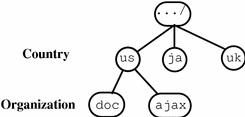Federating X.500/LDAP
X.500 is a global directory service. It stores information and provides the capability to look up information by name as well as to browse and search for information.
X.500 information is held in a directory information base (DIB). Entries in the DIB are arranged in a tree structure. Each entry is a named object and comprises a defined set of attributes. Each attribute has a defined attribute type and one or more values.
An entry is unambiguously identified by a distinguished name that is the concatenation of selected attributes from each entry in the tree along a path leading from the root down to the named entry. For example, using the DIB shown in Figure 22-6,
c=us/o=doc
is a distinguished name of the doc organization in the U.S. Users of the X.500 directory can interrogate and modify the entries and attributes in the DIB.
Figure 22-6 Example of an X.500 Directory Information Base

FNS federates X.500 by supplying the necessary support to permit namespaces to appear to be seamlessly attached below the global X.500 namespace.
For example, FNS facilitates linking the enterprise naming system for the doc organization below X.500. Starting from the initial context, an FNS name to identify the sales organizational unit of the doc organization might be
.../c=us/o=doc/orgunit/sales
The name within the enterprise is simply concatenated onto the global X.500 name. (Note that FNS names use the name "..." in the initial context to indicate that a global name follows.)
Name resolution of FNS names takes place as follows. When an X.500 name is encountered in the global namespace, it is resolved using the X.500 name- resolution mechanism. One of three outcomes is possible:
-
The full name resolves to an X.500 entry. This indicates that the entry is held in X.500. The requested FNS operation is then performed on that entry.
-
A prefix of the full name resolves to an X.500 entry. This indicates that the remainder of the name belongs to a subordinate naming system.
The next naming system pointer (NNSP) to the subordinate naming system is examined to return the XFN reference. Name resolution then continues in the subordinate naming system.
-
An error is reported.
X.500 entries can be examined and modified using FNS operations (subject to access controls). However, it is not currently possible to list the subordinate entries under the root of the X.500 namespace by using FNS.
- © 2010, Oracle Corporation and/or its affiliates
